Established in Tanzania, eastern Africa, in 1951, Serengeti National Park encompasses 5,700 square miles of grassland for its numerous wild animal species, attracting hundreds of thousands of international visitors every year. Now, spanning six separate episodes, Serengeti, created by BBC Earth, is a comprehensive documentary series concerning the natural behavior of the myriad animals in the park.
Directed and executive produced by John Downer, Serengeti, airing in 2019 on the Discovery Channel, received Emmy nominations for its cinematography by DPs Richard Jones, Michael W. Richards, Warren Samuels and Matthew Goodman. It also received a nomination for Lupita Nyong’o’s narration, although in its airing in the United Kingdom, Serengeti’s voiceover narration was provided by John Boyega.
With nearly two years in production, the filmmakers gained access to a well-protected private reserve in the park, a critical facet of the entire Serengeti ecosystem, where the animals are not frightened of people. “They were already very calm in our presence,” Downer remembered. “They need to get used to you and have trust in you. We targeted the animals that we knew were going to deliver a great story.”
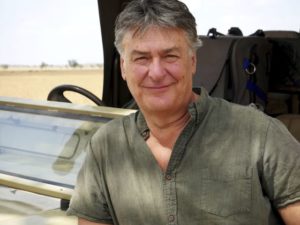
In preparation of photographing the animals, Downer and co-director Simon Fuller focused on specific animal families and followed them consistently, with the drama evolving out of their organic routines. “We were looking for very different types of behaviors,” Downer detailed. “We wanted to be in their world. The whole start of the story was telling it from their point-of-view.”
As the director and one of two Serengeti executive producers, Downer’s self-described vital role was to efficiently work with the writers in crafting the project’s holistic narrative. “The storyline is fundamental to the whole thing,” he conveyed. “The most extraordinary example is the baboon story. That requires an understanding of their behavior, the subtlety of what they were doing. There are similarities to the way humans think—they are very clever, crafty, affectionate friends.”
Creating storylines based on the dramatic expectations for clusters of animal families, Downer and Fuller nevertheless maintained due flexibility. “They are not machines—they are thinking beings with personalities,” Downer revealed of his work in pre-production. “We wanted to have a fluid script—overall arc of the story—that made the most of the behaviors before we encountered them, before we even could shoot like a drama, with loads of different angles: all of the things that you expect in a drama.”
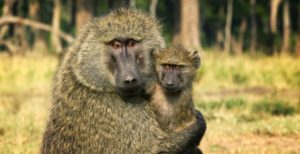
In order to optimally photograph Serengeti, Downer, Fuller, and their cinematography teams tested different pieces of equipment and applied them to their subject. “We wanted to become one of those animals,” described Downer of Serengeti’s style. “We needed to travel with them, often at ground level. We needed to go into the heart of a pride of lions and herd of elephants and be invisible. We did a month of testing and we ended up with ten different styles of filming that would come together to tell this drama.”
When the mélange of animals would focus on the Serengeti filming unit’s cameras, they would often see their reflection within the large cinema lenses. Accidentally but strategically, Downer incorporated those shots into the project. “Looking down into the eye of the animal, in any other use, we would be in danger,” Downer stated. “The audience becomes one of the animals—that really immersive feel. Most of the time, they got so habituated to us being there, we would be involved in the middle of a hunt. We were very close.”
During the testing stage, the concept was to devise a camera system that could be deployed in any field shooting scenario to acquire Serengeti’s necessary footage. “The plan could go out the window in the first ten minutes,” Downer quipped. “Once we were in position, all of the other cameras were deployed—we had three camera crews; two were quite close together. The most important thing was to start filming as soon as something happened, so that we wouldn’t miss it. That was very effective—it’s rare that you are struggling to get the viewpoint that you need.”
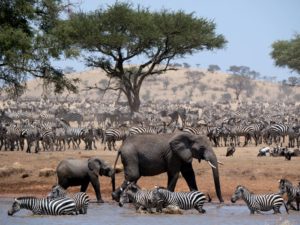
To ensure that there was always coverage, Serengeti’s crews would rotate in and out of the field, with each crew having a month of production and three weeks off, during which the directors would review dailies in a mobile editing room. “One member of the crew was there for most of it,” said Downer who went on nine shoots himself. “You don’t want to leave the characters you are following—you get used to their way of thinking. You don’t always get it right, but it’s easier than if you go away for three weeks.”
Even though Serengeti’s ‘test edits’ were executed in Tanzania, the bulk of the project’s editing was completed at its U.K. base. As such, all parties concentrated on accumulating as much useful material as possible at the park. “We knew that it was going to take over a year, the storyline,” Downer said of field operations. “There were various things built into that story arc: we knew we would likely have drought, which became a dramatic part of that storyline; fire; migrating herds come in. That was built into the schedule. There were multiple editors who worked on storylines—they had key characters. [It was] an additional year of editing as the storylines got refined.”
In post-production, Downer credited his editors, whose skills were so acute, they were able to craft a compelling story with no words. Alas, Lupita Nyong’o was enlisted to provide appropriate narration in a voiceover. “We wanted to tell the story of the Serengeti with the voice of the Serengeti,” said Downer. “It was a matter of refining it and refining it against picture. It’s the Serengeti speaking to us—Lupita had a magical voice: a very musical, lyrical voice. She did it in her Kenyan accent; she was so excited to do that. It takes you on a journey.”
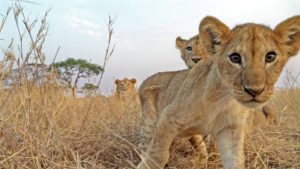
Summarily, Downer suggested that the Serengeti is the greatest place on earth, noting that his series is, in its essence, a big epic drama. “It will transport you to this wonderful place,” he noted. “You are right in the heart of these animals’ lives. You will become part of it.”
One of four Emmy-nominated Serengeti cinematographers, Richard Jones’s goal of photographing the docuseries was to assimilate his camera into the lives of the animals; to feel what they were feeling. “We tried to get into their heads and make it into drama,” said Jones. “We needed to get up close and personal a lot more than the traditional wildlife films, with a long lens with a bit of distance between yourself and the animals. Right from the beginning, we spent time getting the animals used to us, getting closer and closer to them.”
Using remote cameras, Jones and his cohorts would deploy their gear and wait for the animals to approach their photographic devices. “We had to be very careful as filmmakers,” Jones explained, noting that he implemented a variety of stabilization techniques, moving cameras, and cameras mounted near ground level, attached to vehicles. “You want that shot, but the animal might get frightened. You have to work with what they give you; that was challenging at times. You have to work around the position of the sun in relation to the animal.”
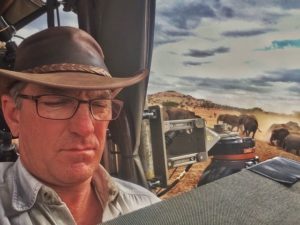
Shooting digitally, Jones captured Serengeti at 4K of resolution. “We had the RED Digital Dragon-Helium camera down to smaller cameras, POV cameras, and some other remote control cameras,” specified Jones who used Canon, Panasonic LUMIX, and Sony lenses. “We spent a whole month just testing gear and seeing what would work and what wouldn’t work—some systems were not reactive enough. Once we started filming, we were pretty set in equipment. 35mm film wasn’t on the drawing board because of the advent of digital cameras; with digital, you have a much greater ability to run the camera for longer. For wildlife, it’s absolutely necessary.”
At times, Jones utilized gimbal technology, which found him leaning outside of a vehicle, tracking alongside animals, and handholding the camera. “We would be on a wide lens, tracking along beside it,” divulged Jones. “Some lions and cheetahs would walk right next to the car. They got used to us being with them. In a hunting mode, you would have to judge if you were affecting the behavior of predator or prey.”
To view this series, please link to: https://go.discovery.com/tv-shows/serengeti.





